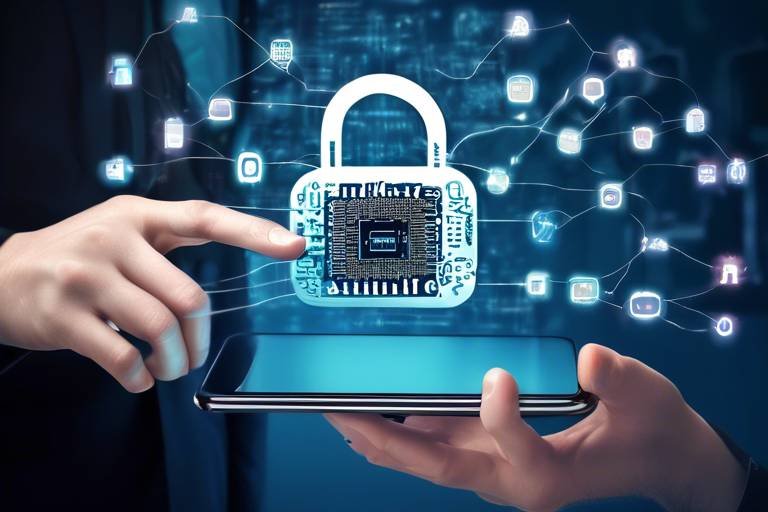How to Safeguard Your Business from Cyber Attacks
In today's digital landscape, the threat of cyber attacks looms over businesses of all sizes. Imagine waking up to find that your sensitive data has been compromised, or that your operations have come to a grinding halt due to a ransomware attack. It's a nightmare scenario that many organizations face, and the stakes have never been higher. That's why understanding how to protect your business from these threats is not just important—it's essential.
Cyber attacks can take many forms, from malware that infiltrates your systems to phishing schemes that trick employees into revealing sensitive information. Ransomware, which locks you out of your own data until a ransom is paid, is also on the rise. With the frequency and sophistication of these attacks increasing, it's crucial to equip yourself with the right strategies to safeguard your business.
So, what can you do to defend your organization against these digital predators? The first step is to understand the landscape. By recognizing the different types of cyber threats that exist, you can better prepare your defenses. For instance, did you know that human error is often the weakest link in cybersecurity? That's why investing in employee training and awareness is just as important as technical solutions.
Next, implementing strong password policies is a must. Weak passwords are akin to leaving the front door of your business wide open. Encourage your team to use complex passwords and change them regularly. Consider using a password manager to help keep track of these credentials securely. Remember, a strong password is your first line of defense against unauthorized access.
Furthermore, fostering a culture of security within your organization can significantly enhance your cybersecurity efforts. When employees understand the importance of security and are actively engaged in protecting sensitive information, they become your best line of defense. Regular security awareness training can help keep everyone informed about the latest threats and safe practices.
Another layer of security that should not be overlooked is Multi-Factor Authentication (MFA). By requiring multiple forms of verification before granting access, you make it significantly more difficult for attackers to breach your systems. Think of it as a double lock on your front door—just because someone has the key doesn’t mean they can simply walk in.
Lastly, keeping your software updated is vital. Cybercriminals often exploit vulnerabilities in outdated systems, making regular updates and patch management essential. Establishing a patch management process ensures that your software is always up to date, minimizing the risk of attacks.
To wrap it up, safeguarding your business from cyber attacks involves a multi-faceted approach. From understanding the types of threats you face to implementing robust security policies and fostering a culture of awareness, every step you take brings you closer to a secure digital environment. Remember, in the world of cybersecurity, it's always better to be proactive than reactive!
- What are the most common types of cyber attacks? The most common types include malware, phishing, and ransomware.
- How can I train my employees on cybersecurity? Regular security awareness training sessions can equip employees with the knowledge to recognize and respond to potential threats.
- Is Multi-Factor Authentication really necessary? Yes, MFA adds an additional layer of security, making it much harder for attackers to gain access to your systems.
- What should I do if I suspect a cyber attack? Immediately notify your IT department and follow your organization’s incident response plan.

Understanding Cyber Threats
In today's digital landscape, businesses face an array of cyber threats that can jeopardize their operations, reputation, and even their very existence. Understanding these threats is the first step in safeguarding your organization. So, what exactly are these threats? They come in various forms, each with its own modus operandi.
One of the most notorious threats is malware, which is malicious software designed to harm, exploit, or otherwise compromise your computer systems. This can include viruses, worms, and Trojans. Imagine malware as a digital burglar that sneaks into your system and wreaks havoc, stealing sensitive information or crippling your operations.
Another prevalent threat is phishing. This is a method used by cybercriminals to trick individuals into divulging sensitive information, such as usernames and passwords. Phishing often comes in the form of deceptive emails or messages that appear to be from legitimate sources. It's like a wolf in sheep's clothing, luring you in with a false sense of security.
Then there's ransomware, a particularly vicious type of malware that encrypts your files and demands payment for their release. Imagine waking up to find all your important documents locked away, with a ransom note on your screen. This type of attack not only disrupts business operations but can also lead to significant financial losses.
To better grasp these threats, let's take a look at a brief comparison of the different types of cyber threats:
| Type of Threat | Description | Impact |
|---|---|---|
| Malware | Malicious software that damages or disrupts systems. | Data loss, system downtime, financial loss. |
| Phishing | Fraudulent attempts to obtain sensitive information. | Identity theft, unauthorized access. |
| Ransomware | Software that locks files and demands a ransom. | Data loss, financial loss, reputational damage. |
By understanding these various cyber threats, businesses can take proactive measures to protect themselves. It's crucial to stay informed about the latest trends in cybercrime, as attackers are constantly evolving their tactics. Ignorance is not bliss in the digital world; it can lead to devastating consequences.
In conclusion, recognizing and understanding cyber threats is essential for any business. It's not just about having the right technology in place but also about fostering a security-first mindset within your organization. After all, in the fight against cybercrime, knowledge is power!

Implementing Strong Password Policies
In the digital age, where everything is interconnected, safeguarding your business starts with the simplest yet most effective tool: strong passwords. You might think, "Isn't a password just a string of characters?" Well, it’s much more than that! A strong password acts as the first line of defense against cyber threats. Just like you wouldn’t leave your front door unlocked, you shouldn’t leave your digital assets vulnerable with weak passwords.
To truly understand the significance of implementing strong password policies, let’s consider the staggering statistics. According to recent studies, over 80% of data breaches are due to weak or stolen passwords. That’s a jaw-dropping number! By establishing robust password policies, businesses can drastically reduce the risk of unauthorized access to sensitive information. So, what exactly constitutes a strong password? Here are some key components:
- Length: Aim for at least 12-16 characters. The longer, the better!
- Complexity: Use a mix of uppercase letters, lowercase letters, numbers, and special characters.
- Avoid common words: Steer clear of easily guessable information like "password," "123456," or personal details.
Now, just having strong passwords isn’t enough. It’s essential to ensure that these passwords are managed effectively. This is where a password manager can be invaluable. Password managers not only generate strong passwords but also store them securely, making it easier for employees to use unique passwords for different accounts without the risk of forgetting them. Think of it as a digital vault for your passwords!
Another vital aspect of password policies is the requirement for regular password changes. While it may seem tedious, changing passwords every few months can significantly decrease the chances of a breach. This practice helps to mitigate risks, especially if an employee’s password has been compromised without their knowledge. It’s like changing the locks on your doors periodically; it’s a proactive approach to security.
In addition to creating strong passwords and enforcing regular changes, consider implementing a password expiration policy. This means that after a certain period, employees will be required to update their passwords. Coupled with this, educating your team on recognizing phishing attempts is essential. After all, even the strongest password can be compromised through social engineering tactics.
To summarize, here’s a quick checklist for implementing strong password policies:
| Action | Description |
|---|---|
| Set minimum length | Require passwords to be at least 12 characters long. |
| Encourage complexity | Include a mix of letters, numbers, and special characters. |
| Utilize password managers | Store and generate strong passwords securely. |
| Implement regular changes | Require employees to update passwords every 3-6 months. |
| Educate on phishing | Train staff to recognize and avoid phishing attempts. |
By following these guidelines and fostering a culture of security, your business can significantly enhance its defenses against cyber threats. Remember, in the realm of cybersecurity, a strong password is not just a necessity; it’s a powerful shield protecting your valuable data and ensuring the integrity of your operations.
Q: How often should I change my passwords?
A: It’s advisable to change passwords every 3-6 months to minimize the risk of breaches.
Q: Can I use the same password for multiple accounts?
A: No, using unique passwords for different accounts is crucial to prevent a breach from affecting multiple services.
Q: What should I do if I suspect my password has been compromised?
A: Immediately change your password and monitor your accounts for any unusual activity.

Educating Employees on Cybersecurity
In the digital age, where information flows like water, is not just a good idea; it's a necessity. Think of your organization as a castle, and your employees are the guards. Without proper training, even the most fortified walls can be breached. Cyber threats are evolving rapidly, and if your team isn't equipped with the right knowledge, they could unwittingly open the gates to hackers. So, how do we ensure that every guard knows their duty?
First and foremost, it's essential to create a comprehensive training program that covers the basics of cybersecurity. This program should include topics such as recognizing phishing emails, understanding the importance of strong passwords, and knowing how to report suspicious activity. You wouldn't send your guards into battle without armor, would you? Similarly, your employees need the right tools and knowledge to defend against cyber attacks.
Moreover, the training shouldn't be a one-time event. Just like any skill, cybersecurity awareness needs to be practiced and reinforced regularly. Consider implementing monthly training sessions or workshops that focus on the latest threats and safe practices. This not only keeps the information fresh in their minds but also fosters a culture of security within your organization. When employees feel empowered and knowledgeable, they are more likely to take proactive measures to protect sensitive information.
To make the training more engaging, incorporate real-world scenarios and simulations. For instance, you could conduct a mock phishing attack to see how employees respond. This hands-on approach helps them recognize potential threats in a controlled environment, making them more vigilant in their day-to-day activities. Additionally, sharing success stories—where an employee spotted a phishing attempt or reported suspicious activity—can boost morale and encourage others to stay alert.
Furthermore, it's crucial to establish a clear communication channel for reporting cybersecurity concerns. Employees should feel comfortable reaching out if they suspect something is amiss. You might even consider creating an anonymous reporting system to alleviate any fears of repercussions. After all, it's better to be safe than sorry, and a quick report could save your organization from a potential breach.
Lastly, remember that cybersecurity is a shared responsibility. Encourage employees to share their knowledge and experiences with one another. This could be through informal discussions, team meetings, or even a dedicated channel on your internal communication platform. By fostering an environment where everyone looks out for each other, you create a robust defense against cyber threats.
In summary, educating employees on cybersecurity is a vital step in safeguarding your business. By providing ongoing training, engaging them with real-world scenarios, and fostering a culture of security, you empower your team to be the first line of defense against cyber attacks.
- Why is employee education important in cybersecurity? Employee education is crucial because human error is often the weakest link in cybersecurity. Educated employees can recognize threats and respond appropriately.
- How often should cybersecurity training be conducted? Regular training sessions, ideally monthly, help keep cybersecurity awareness fresh and relevant as threats evolve.
- What topics should be covered in cybersecurity training? Topics should include phishing recognition, password management, reporting procedures, and the importance of software updates.
- How can I make training engaging? Incorporate real-world scenarios, interactive simulations, and success stories to make the training more relatable and impactful.

Regular Security Awareness Training
In today's digital landscape, where cyber threats loom large, is not just a luxury—it's a necessity. Think of it as the armor that protects your business from the relentless barrage of cyber attacks. Just as a knight wouldn’t venture into battle without their shield, your employees shouldn't navigate the digital world without the right knowledge and tools to fend off potential threats. By conducting these training sessions, you're not only educating your team but also empowering them to become the first line of defense against cybercriminals.
So, what exactly does regular security awareness training entail? It involves equipping your staff with the latest information on emerging threats and the best practices to mitigate them. This training can cover a variety of topics, including:
- Recognizing phishing attempts
- Understanding the importance of strong passwords
- Identifying suspicious links and attachments
- Learning how to report potential security incidents
Moreover, the effectiveness of such training is amplified when it is conducted regularly. Cyber threats are constantly evolving, and what was relevant last year might not be applicable today. By scheduling frequent training sessions, you ensure that your employees stay informed about the latest tactics used by cybercriminals. This ongoing education fosters a culture of vigilance and awareness, making security an integral part of your business operations.
Additionally, incorporating interactive elements into your training can significantly enhance engagement. For instance, consider using real-life scenarios or simulations that allow employees to practice their responses to potential threats. This hands-on approach not only makes the training more enjoyable but also reinforces the lessons learned, ensuring that your team retains critical information when it matters most.
To further illustrate the importance of regular training, let’s take a look at some statistics:
| Statistic | Impact |
|---|---|
| 70% of cyber attacks start with a phishing email | Awareness can reduce susceptibility to such attacks. |
| Companies that train employees on security can reduce incidents by 50% | Regular training leads to improved response times and reduced risks. |
In conclusion, regular security awareness training is a vital component of any robust cybersecurity strategy. It not only prepares your employees to recognize and respond to threats but also cultivates a proactive security culture within your organization. Remember, in the battle against cybercrime, knowledge is power, and training is your best weapon.
Q: How often should security awareness training be conducted?
A: Ideally, security awareness training should be conducted at least quarterly to keep employees updated on the latest threats.
Q: What topics should be covered in security awareness training?
A: Topics can include phishing recognition, password management, safe internet practices, and incident reporting.
Q: Can security awareness training be conducted online?
A: Yes, many organizations offer online training modules that employees can complete at their convenience.
Q: How can I measure the effectiveness of the training?
A: You can assess effectiveness through quizzes, simulations, and tracking incident reports before and after training.

Creating a Culture of Security
In today's digital landscape, creating a culture of security within your organization is not just a good idea; it's essential. Think of your business as a fortress, and every employee is a guard. If one guard is not vigilant, the entire fortress is at risk. By fostering an environment where security is prioritized and integrated into daily operations, you can significantly reduce the likelihood of a cyber incident. But how do you achieve this?
First and foremost, it's crucial to lead by example. Management should actively participate in security training and adhere to policies. When employees see leaders taking security seriously, they are more likely to follow suit. Regular communication about security practices, updates on potential threats, and the importance of vigilance can keep security at the forefront of everyone's mind.
Next, consider implementing open forums where employees can discuss security concerns and share insights. This not only encourages communication but also empowers staff to take ownership of their role in maintaining security. When employees feel they have a voice, they are more likely to be proactive about identifying and reporting suspicious activities. It’s like having a neighborhood watch; everyone looks out for one another.
Additionally, gamifying the training process can be an effective way to engage employees. Consider creating challenges or competitions that reward those who excel in security practices. This approach not only makes learning fun but also reinforces the importance of cybersecurity in a memorable way. After all, who doesn't enjoy a little friendly competition?
Finally, it's vital to recognize and reward employees who demonstrate good security practices. A simple acknowledgment or a small reward can go a long way in reinforcing positive behavior. This could be as straightforward as a shout-out in a team meeting or a more formal recognition program. When employees feel appreciated, they are more likely to continue their diligent efforts in maintaining security.
In summary, creating a culture of security is about more than just policies and procedures; it’s about instilling a mindset that values security at every level. By leading by example, encouraging open communication, gamifying training, and recognizing good practices, you can build a robust security culture that not only protects your business but also empowers your employees.
- What is a culture of security? A culture of security refers to an organizational environment where security is prioritized, and all employees are actively engaged in maintaining it.
- How can I encourage my team to take cybersecurity seriously? Lead by example, provide regular training, and create an open dialogue about security concerns.
- Why is employee involvement important in cybersecurity? Employees are often the first line of defense against cyber threats; their vigilance can help identify and mitigate risks early.
- What are some effective ways to train employees on cybersecurity? Regular training sessions, gamification of learning, and real-world scenarios can enhance understanding and retention.

Implementing Multi-Factor Authentication
In today's digital landscape, where cyber threats lurk around every corner, implementing Multi-Factor Authentication (MFA) is no longer a luxury but a necessity for businesses of all sizes. Imagine leaving your front door wide open, trusting that no one would dare to enter your home. That’s what relying solely on passwords feels like in the cybersecurity world. MFA adds an extra layer of protection, making it significantly harder for cybercriminals to breach your security, even if they manage to steal your password.
MFA works by requiring users to provide two or more verification factors to gain access to a resource, such as an application or online account. These factors typically fall into three categories:
- Something you know: This could be a password or a PIN.
- Something you have: This might include a smartphone app that generates a time-sensitive code, a hardware token, or a smart card.
- Something you are: This refers to biometric verification, such as fingerprints or facial recognition.
By combining these factors, MFA creates a formidable barrier against unauthorized access. For instance, even if a hacker gets hold of your password, they would still need access to your phone or a biometric feature to complete the login process. This multi-layered approach not only enhances security but also builds trust with your customers, who want to know that their sensitive information is safeguarded.
Moreover, implementing MFA can be a straightforward process, thanks to various tools and platforms available today. Many popular services, like Google and Microsoft, offer built-in MFA options that are easy to configure. However, businesses must ensure that they communicate the importance of MFA to their employees and provide adequate training on how to use it effectively. After all, even the best security measures can fall flat if users don't understand how to utilize them properly.
In addition to protecting sensitive data, MFA can also help organizations comply with industry regulations that mandate stronger security measures. For example, sectors like finance and healthcare often require businesses to implement MFA to protect customer data. By adopting MFA, you not only enhance your security posture but also align with compliance requirements, avoiding potential fines and legal issues.
In conclusion, implementing Multi-Factor Authentication is a critical step in safeguarding your business from cyber threats. It’s like adding multiple locks to your door, ensuring that even if one is compromised, others remain secure. As you navigate the complexities of cybersecurity, remember that the goal is not just to defend against attacks but to create a culture of security awareness that permeates your entire organization.
Q1: What are the main benefits of using Multi-Factor Authentication?
A1: MFA significantly reduces the risk of unauthorized access, enhances compliance with regulations, builds customer trust, and can be implemented easily using various tools.
Q2: Can MFA be used for all types of accounts?
A2: Yes, most online services and applications now offer MFA options, making it applicable for a wide range of accounts, from email to banking.
Q3: What should I do if I lose access to my MFA device?
A3: Most services provide backup codes or recovery options. It's essential to keep these in a secure location to regain access if needed.

Regular Software Updates and Patching
In the fast-paced world of technology, keeping your software up to date is not just a good practice; it's a necessity. Think of software updates as the armor your business wears against the relentless barrage of cyber threats. Just like a knight wouldn’t go into battle with rusty armor, your business shouldn’t operate on outdated software. Cybercriminals are constantly on the lookout for vulnerabilities to exploit, and outdated software is like leaving the door wide open for them. By regularly updating your software, you essentially close those doors and reinforce your defenses.
Consider the last time you updated your smartphone or your computer. Those updates often come with new features, but they also include crucial security patches that fix vulnerabilities. If you delay these updates, it’s akin to ignoring a warning sign on a busy highway. You’re inviting trouble. According to a report by Cybersecurity Ventures, cybercrime is expected to cost the world $10.5 trillion annually by 2025. This staggering figure underscores the importance of maintaining up-to-date software and systems.
So, how can you ensure that your organization stays ahead of the game? Establishing a systematic approach to software updates and patching is key. Here are some essential steps to consider:
- Schedule Regular Updates: Create a routine for checking and applying updates. This could be weekly, monthly, or quarterly, depending on your business needs.
- Prioritize Critical Updates: Not all updates are created equal. Some patches address serious vulnerabilities that could lead to data breaches. Prioritize these updates to ensure your systems are secure.
- Automate When Possible: Many software applications offer automatic updates. Enabling this feature can save time and reduce the risk of human error.
Moreover, keeping track of which software requires updates can be daunting, especially for larger organizations. This is where a patch management process comes into play. A well-structured patch management process can help streamline the update process, ensuring that no software is left behind. This process involves:
| Step | Description |
|---|---|
| Inventory Software | Keep a detailed list of all software in use within the organization. |
| Monitor for Updates | Regularly check for updates from software vendors. |
| Test Updates | Before widespread deployment, test updates in a controlled environment to identify any potential issues. |
| Deploy Updates | Roll out updates organization-wide, ensuring all systems are covered. |
| Review and Document | Keep records of updates applied and any issues encountered during the process. |
Additionally, monitoring for suspicious activity is crucial after updates are applied. Sometimes, updates can inadvertently cause issues or conflicts within your systems. By keeping an eye on your network post-update, you can swiftly address any anomalies that may arise.
In conclusion, regular software updates and patching are vital components of a strong cybersecurity strategy. They not only protect your business from known vulnerabilities but also help maintain the integrity and reliability of your systems. Remember, in the digital landscape, staying ahead is not just about having the latest technology; it’s about ensuring that technology is secure. Don’t wait for a breach to happen; take proactive steps today to safeguard your business.
Q: How often should I update my software?
A: It’s recommended to check for updates at least once a month, but critical updates should be applied as soon as they are available.
Q: Can I automate software updates?
A: Yes, many software applications have an option for automatic updates, which can help ensure you don’t miss important security patches.
Q: What should I do if an update causes problems?
A: If an update leads to issues, revert to the previous version if possible and consult with your IT team or the software vendor for assistance.

Establishing a Patch Management Process
In the digital landscape, where cyber threats lurk around every corner, establishing a patch management process is not just advisable; it's essential. Think of your software like a fortress. If the walls are crumbling due to outdated patches, intruders can easily breach your defenses. A robust patch management process ensures that your organization remains fortified against vulnerabilities that cybercriminals are eager to exploit.
First and foremost, it's crucial to identify which software and systems require regular updates. This includes not only your operating systems but also applications, plugins, and any third-party software. Maintaining an inventory of all software assets can help streamline this process. Consider using a centralized patch management tool that helps automate the detection of updates and installations across your network. This can save time and reduce human error, which is often a significant vulnerability in cybersecurity.
Once you've identified the software that needs attention, the next step is to prioritize these patches. Not all vulnerabilities are created equal. Some pose a higher risk than others, so assessing the severity of each vulnerability is paramount. You can categorize them into different levels of urgency:
| Severity Level | Description | Action Required |
|---|---|---|
| Critical | Exploitable vulnerabilities that can lead to severe damage. | Immediate patching required. |
| High | Vulnerabilities that can significantly impact operations. | Patch within a week. |
| Medium | Vulnerabilities that pose a moderate risk. | Patch within a month. |
| Low | Minor vulnerabilities that are less likely to be exploited. | Patch as resources allow. |
After prioritization, the next step is to implement the patches. This should be done in a controlled manner. It’s wise to test patches in a staging environment before rolling them out to your entire network. This helps ensure that the patch won’t disrupt operations or create compatibility issues with existing systems. Once testing is complete, you can proceed with deploying the patches across your organization.
Moreover, documentation is a critical aspect of the patch management process. Keeping a detailed record of what patches have been applied, when, and to which systems can help in audits and compliance checks. It also assists in troubleshooting if any issues arise post-deployment. Consider setting up a schedule for regular reviews of your patch management process to adapt to new threats and ensure that your practices remain effective.
Finally, communication is key. Keep all stakeholders informed about the patch management process, including any potential downtime that may occur during updates. This transparency helps build trust and ensures that everyone is on the same page regarding cybersecurity efforts.
In summary, establishing a patch management process is a proactive measure that can significantly enhance your organization’s cybersecurity posture. By identifying, prioritizing, and implementing patches effectively, you can fortify your defenses against the ever-evolving landscape of cyber threats.
- What is patch management? Patch management is the process of managing updates for software applications and technologies, ensuring that vulnerabilities are addressed promptly.
- Why is patch management important? It is crucial because unpatched software can lead to security vulnerabilities, making your systems susceptible to cyber attacks.
- How often should I update my software? Regular updates should be part of your routine; however, critical patches should be applied as soon as they are released.
- Can I automate patch management? Yes, many tools are available that can automate the detection and application of patches, reducing manual effort and error.

Monitoring for Suspicious Activity
In today's digital landscape, is not just a good practice; it's a necessity. Imagine your business as a bustling city. Just as a city employs security cameras and patrols to keep an eye on its streets, your organization must have the right tools and strategies in place to detect and respond to cyber threats. Cybercriminals are constantly on the lookout for vulnerabilities, and without vigilant monitoring, your business could become their next target.
So, what does effective monitoring look like? It involves a combination of advanced technologies and human oversight. Utilizing intrusion detection systems (IDS) and security information and event management (SIEM) solutions can help you identify unusual patterns that may indicate a breach. For instance, if an employee accesses sensitive data at odd hours or from a foreign IP address, these systems can alert your IT team to investigate further. The key is to be proactive rather than reactive.
Moreover, it's essential to establish a baseline of normal activity within your network. By understanding what "normal" looks like, you can more easily spot anomalies. This could include typical login times, data access patterns, and user behaviors. When an event deviates from this norm, it raises a red flag. Think of it like a dog bark—if it happens at the same time every day, you might ignore it, but if it starts barking at midnight, you’ll definitely want to check it out.
To enhance your monitoring efforts, consider implementing a layered approach. This means combining various tools and strategies to create a comprehensive security posture. Here are some components to include:
- Real-time alerts: Set up notifications for suspicious activities, so your security team can respond immediately.
- Regular audits: Conduct periodic reviews of your security logs to identify any overlooked threats.
- Employee feedback: Encourage staff to report any unusual behavior they notice, as they are often the first line of defense.
In addition, it's crucial to have a clear incident response plan in place. This plan should outline the steps your team will take when suspicious activity is detected. Think of it as a fire drill; you want everyone to know their role and the actions they need to take when the alarm rings. This preparedness can significantly reduce the impact of a cyber incident and help you recover more quickly.
Lastly, continuous training and awareness are vital. Regularly updating your team on the latest cybersecurity trends and tactics can empower them to recognize and report suspicious activity. Cybersecurity is a team effort, and when everyone is engaged, your defenses become much stronger.
Q: How often should we monitor for suspicious activity?
A: Continuous monitoring is ideal, but at a minimum, you should review your logs and alerts daily. Regular audits can also help catch any anomalies that may have slipped through the cracks.
Q: What tools are recommended for monitoring?
A: Look into solutions like SIEM systems, intrusion detection systems (IDS), and endpoint detection and response (EDR) tools. Each offers different features that can help you monitor for suspicious activity effectively.
Q: What should I do if I detect suspicious activity?
A: Follow your incident response plan. Investigate the alert, gather relevant data, and escalate the issue to your security team. Quick action can help mitigate potential damage.
Frequently Asked Questions
- What are the most common types of cyber threats businesses face?
Businesses today are up against a variety of cyber threats, including malware, which can disrupt operations; phishing, where attackers trick employees into giving away sensitive information; and ransomware, which locks up your data until a ransom is paid. Understanding these threats is the first step in safeguarding your business.
- How can strong password policies help protect my business?
Implementing strong password policies is like putting a solid lock on your front door. It significantly reduces the risk of unauthorized access to sensitive information. Encourage your team to use complex passwords, change them regularly, and avoid reusing passwords across different accounts.
- Why is employee training essential for cybersecurity?
Think of your employees as the first line of defense against cyber attacks. Regular training equips them with the knowledge to recognize and respond to potential threats. By fostering awareness, you empower your staff to act as vigilant guardians of your company's data.
- What is multi-factor authentication and why should I use it?
Multi-factor authentication (MFA) adds an extra layer of security by requiring users to provide two or more verification factors to gain access. It's like needing both a key and a code to enter a vault. This makes it much harder for attackers to breach your systems, even if they have your password.
- How often should I update my software?
Regular software updates are crucial in protecting your business from vulnerabilities that cybercriminals exploit. Aim to update your software as soon as patches are released. Establishing a patch management process can help ensure that your systems are always protected.
- What steps should I take for monitoring suspicious activity?
Continuous monitoring is vital for identifying unusual activities within your network. Implement tools that can alert you to suspicious behavior, and establish a response plan for when potential threats are detected. This proactive approach can help mitigate damage before it escalates.



















